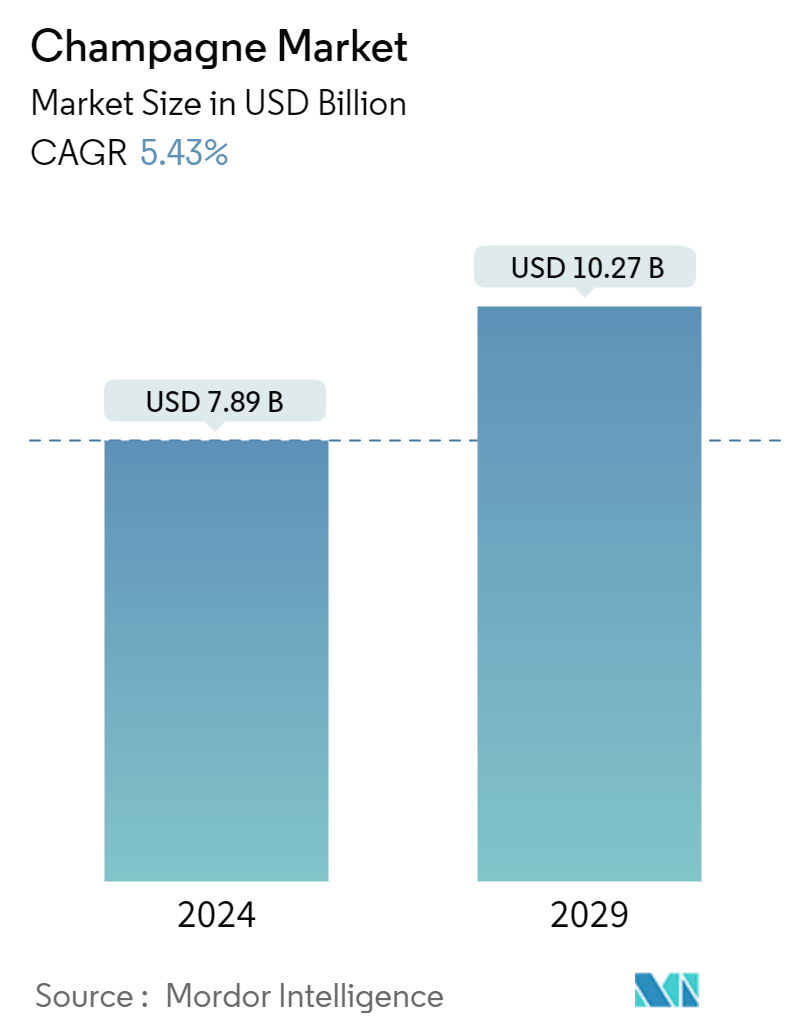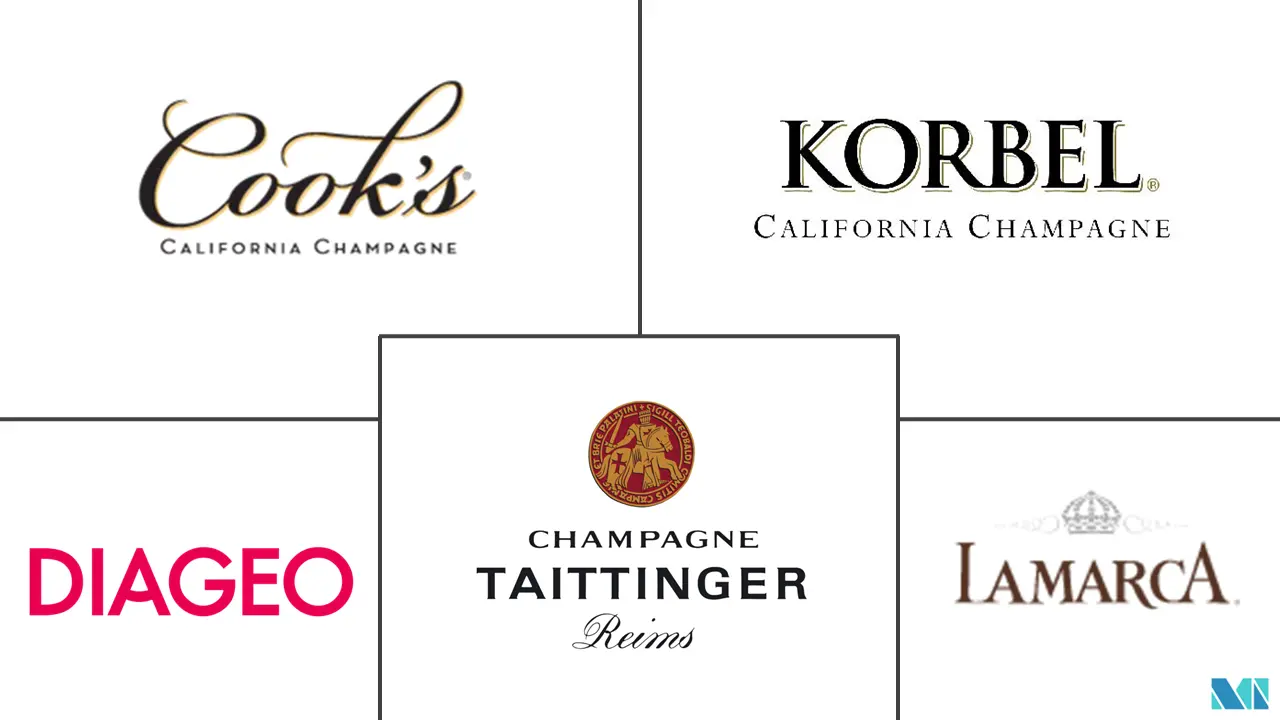Market Size of Champagne Industry

| Study Period | 2019 - 2029 |
| Market Size (2024) | USD 7.89 Billion |
| Market Size (2029) | USD 10.27 Billion |
| CAGR (2024 - 2029) | 5.43 % |
| Fastest Growing Market | Asia-Pacific |
| Largest Market | North America |
Major Players
*Disclaimer: Major Players sorted in no particular order |
Champagne Market Analysis
The Champagne Market size is estimated at USD 7.89 billion in 2024, and is expected to reach USD 10.27 billion by 2029, growing at a CAGR of 5.43% during the forecast period (2024-2029).
Champagne is made from various grapes and flavors like citrus, apple, and almond. Demand for champagne is increasing in the regions like Europe and North America because of the increase in food service restaurants and bars. People used to have champagne for special occasions like achievements or weddings. But these days, casual drinking on birthdays, office parties, and dinners is increased in the region. Furthermore, vintage wines and champagnes are gaining popularity worldwide because of consumer awareness regarding authentic flavors and tastes. Over the medium term, industry premiumization remains one of the major factors driving the alcoholic beverage market, particularly spirits and wine.
Due to the increased disposable income, consumers quickly buy expensive luxury champagnes for their special occasions. Product innovations by manufacturers regarding the usage of organic/natural and vegan ingredients, as well as eco-friendly packaging in the case of champagne, are allowing deeper penetration and expansion to new markets across the globe. For instance, in April 2021, Ruinart Champagne launched the new Eco-Friendly Second Skin Packaging for its champagne. The new 100% paper case is fully recyclable and can withstand an ice bucket chill for several hours before deteriorating. The innovative design was created to maintain the wine's integrity by blocking incoming light while keeping the case conscious of the planet.
Champagne Industry Segmentation
Champagne is a sparkling wine that originated and was produced in France. The Champagne Market is segmented by type, distribution channel, and geography. The market is segmented by type into brut champagne, rosé champagne, blanc de Blancs, blanc de noirs, demi-sec, and prestige cuvée and by distribution channel into on-trade and off-trade. Off-Trade is further segmented into online retail stores and offline retail stores. The market is segmented based on geography: North America, Europe, Asia-Pacific, South America, the Middle East, and Africa. For each segment, the market sizing and forecasts have been done based on value (in USD million).
| Type | |
| Brut Champagne | |
| Rose Champagne | |
| Blanc De Blancs | |
| Blanc De Noirs | |
| Demi-Sec | |
| Prestige Cuvee |
| Distribution Channel | ||||
| On-Trade | ||||
|
| Geography | |||||||||
| |||||||||
| |||||||||
| |||||||||
| |||||||||
|
Champagne Market Size Summary
The champagne market is experiencing a robust growth trajectory, driven by increasing consumer demand in regions such as Europe and North America. This demand is fueled by the rise of food service establishments and a shift in consumer behavior towards casual consumption occasions, such as birthdays and office parties, rather than solely special events. The market is also witnessing a trend towards premiumization, with vintage wines and champagnes gaining popularity due to heightened consumer awareness of authentic flavors. The introduction of organic, natural, and vegan ingredients, along with eco-friendly packaging innovations, is further propelling market expansion. Notable examples include Ruinart Champagne's launch of a recyclable paper case designed to maintain the wine's integrity while being environmentally conscious.
The market's growth is also supported by the increasing popularity of online retailing and on-demand delivery services, which offer convenient purchasing options for consumers. The expansion of direct-to-consumer channels has become particularly attractive as traditional sales avenues face challenges. Additionally, the champagne market benefits from the growing import-export potential and the expansion of bars and restaurants, especially in countries like China, India, and Japan. European countries, where champagne is deeply rooted, continue to hold a significant share of global consumption, with a substantial portion of production exported worldwide. The market is characterized by intense competition among global and regional players, who are actively engaging in mergers, acquisitions, and product innovations to capture a larger market share.
Champagne Market Size - Table of Contents
-
1. MARKET DYNAMICS
-
1.1 Market Drivers
-
1.2 Market Restraints
-
1.3 Industry Attractiveness - Porter's Five Forces Analysis
-
1.3.1 Bargaining Power of Suppliers
-
1.3.2 Bargaining Power of Buyers/Consumers
-
1.3.3 Threat of New Entrants
-
1.3.4 Threat of Substitute Products
-
1.3.5 Intensity of Competitive Rivalry
-
-
-
2. MARKET SEGMENTATION
-
2.1 Type
-
2.1.1 Brut Champagne
-
2.1.2 Rose Champagne
-
2.1.3 Blanc De Blancs
-
2.1.4 Blanc De Noirs
-
2.1.5 Demi-Sec
-
2.1.6 Prestige Cuvee
-
-
2.2 Distribution Channel
-
2.2.1 On-Trade
-
2.2.2 Off-Trade
-
2.2.2.1 Online Retail Stores
-
2.2.2.2 Offline Retail Stores
-
-
-
2.3 Geography
-
2.3.1 North America
-
2.3.1.1 United States
-
2.3.1.2 Canada
-
2.3.1.3 Mexico
-
2.3.1.4 Rest of North America
-
-
2.3.2 Europe
-
2.3.2.1 United Kingdom
-
2.3.2.2 Germany
-
2.3.2.3 Spain
-
2.3.2.4 France
-
2.3.2.5 Italy
-
2.3.2.6 Russia
-
2.3.2.7 Rest of Europe
-
-
2.3.3 Asia-Pacific
-
2.3.3.1 China
-
2.3.3.2 Japan
-
2.3.3.3 India
-
2.3.3.4 Australia
-
2.3.3.5 Rest of Asia-Pacific
-
-
2.3.4 South America
-
2.3.4.1 Brazil
-
2.3.4.2 Argentina
-
2.3.4.3 Rest of South America
-
-
2.3.5 Middle-East and Africa
-
2.3.5.1 South Africa
-
2.3.5.2 Saudi Arabia
-
2.3.5.3 Rest of Middle East and Africa
-
-
-
Champagne Market Size FAQs
How big is the Champagne Market?
The Champagne Market size is expected to reach USD 7.89 billion in 2024 and grow at a CAGR of 5.43% to reach USD 10.27 billion by 2029.
What is the current Champagne Market size?
In 2024, the Champagne Market size is expected to reach USD 7.89 billion.

